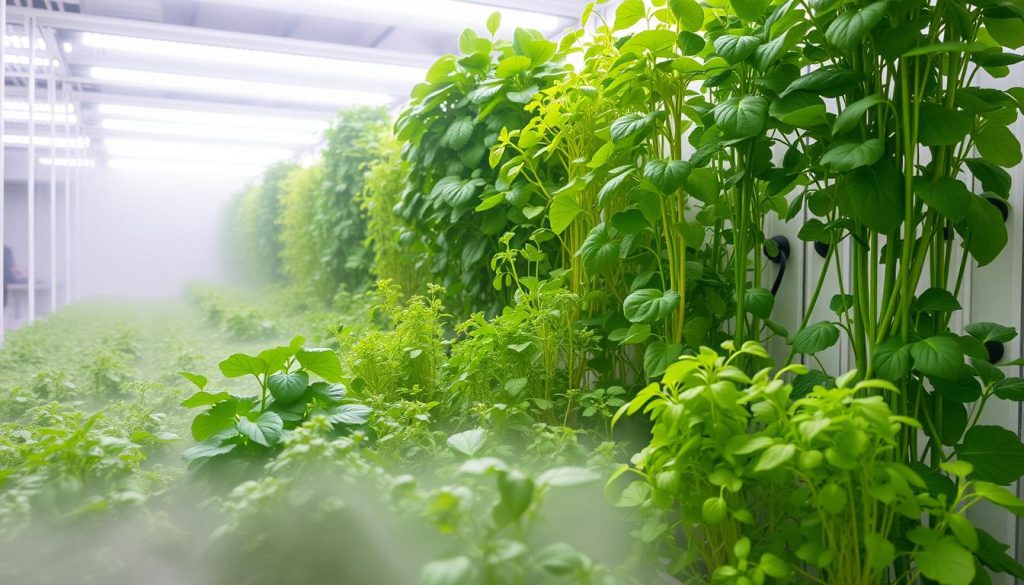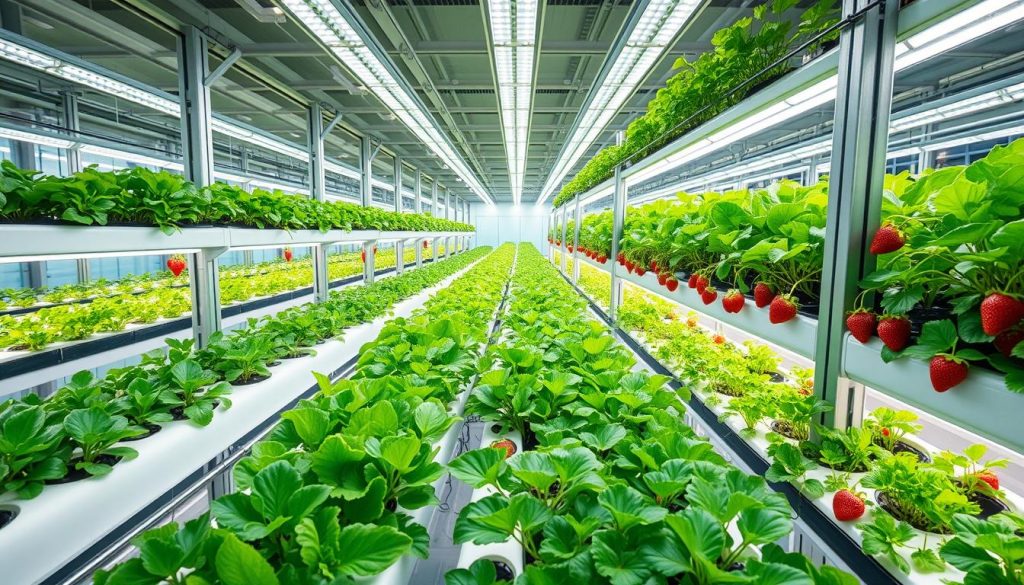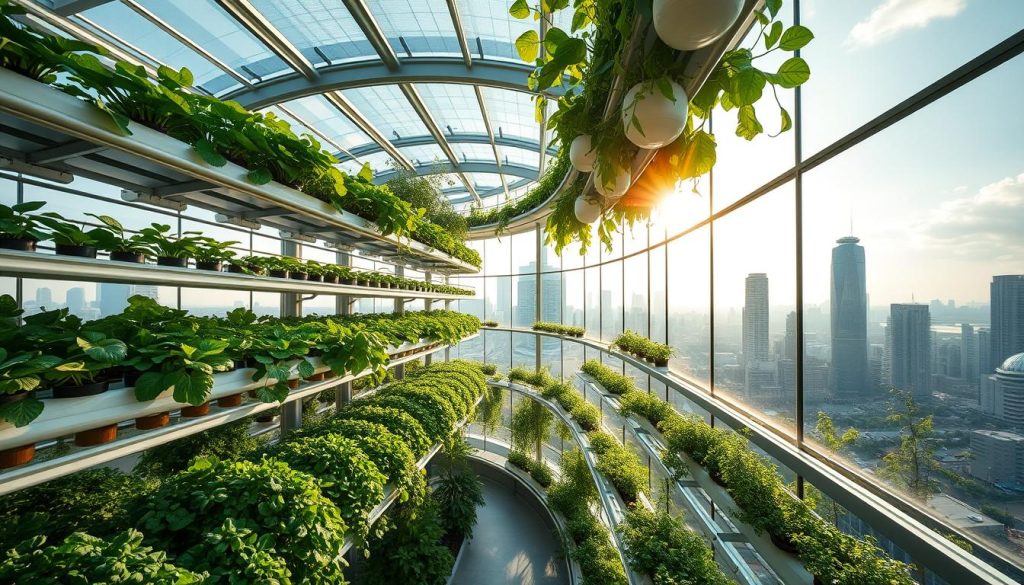The world’s population is growing fast, and old farming ways are facing big problems. These include climate change, running out of resources, and not enough land. But, a new way of farming called hydroponics is changing everything. It grows plants without soil, which could be the future of food.

Hydroponics is all about growing plants in water that’s full of nutrients. It’s a smart way to solve the world’s food problem. This method uses way less water than old farming, up to 90%. Plus, plants grow 25-30% faster because they get nutrients right away.
New tech like vertical farming and controlled environments are making hydroponics even better. These tools help grow more food in less space. Now, even cities and tough places can have lots of fresh, healthy food.
Key Takeaways
- Hydroponics uses up to 90% less water compared to traditional agriculture
- Plants in hydroponic systems grow 25-30% faster due to direct access to nutrients
- Hydroponic systems enable higher yields through better control over growing conditions
- Hydroponics is being adopted by nonprofits, schools, hospitals, and zoos to improve food access and sustainability
- Advances in technology, such as vertical farming and renewable energy integration, are further enhancing the potential of hydroponics
Understanding the Global Food Crisis
The world is facing a big challenge in food production. We need to increase food output by 70% to feed 9.8 billion people by 2050. But, traditional farming can’t keep up because of resource depletion, land scarcity, and climate change.
Current Agricultural Challenges
Deforestation for farming harms biodiversity and increases carbon emissions. Water scarcity and soil degradation make food security harder. In 2014, 8.6% of people were undernourished, and now it’s 8.9%. From 2018 to 2019, 10 million more people became hungry.
Population Growth and Food Demand
The growing global population means more food is needed. This pressure has led to looking for new ways to farm, like hydroponics. It’s a way to produce food sustainably and reliably.
Resource Depletion Issues
Traditional farming uses too much water and soil. Hydroponics, however, uses up to 98% less water. It also doesn’t need pesticides or chemicals, which is better for the environment.
What is Hydroponic Farming?
Hydroponic farming is a new way to grow plants without soil. Plants grow in water or mist that’s full of nutrients. This method gives plants exactly what they need to grow well.
It lets farmers grow food all year, even in cities. This is great for solving the world’s food problems.
There are many types of hydroponic systems. Each one is made for different plants. You can find NFT, Ebb and Flow, Drip Systems, and Aeroponics. These systems control the growing environment closely.
They make sure plants get the right nutrients and water. This helps plants grow strong and healthy.
The history of hydroponics goes back over a century. The Hanging Gardens of Babylon were one of the first examples. Since then, new ways to grow plants have been developed.
Now, more people are using hydroponics. It saves water, cuts down on harmful chemicals, and boosts crop yields. It’s good for farmers, gardeners, and big growers too.
As the world’s population grows, hydroponics can help feed everyone. It’s a green and efficient way to grow food.
A hydroponic system has many parts. You need a growing tray, a nutrient reservoir, and a pump. There are also air pumps, lights, and software to monitor everything.
These parts work together to create a perfect growing space. Plants can thrive without soil.
Learning about hydroponics opens up new ways to grow food. It’s exciting for both small gardens and big farms. Hydroponics could change the future of farming.
The Science Behind Soilless Growing
Hydroponic farming changes how we grow plants by not needing soil. Plants get nutrients directly from water, helping them grow better. This method saves resources and lets growers control the growing space exactly.
Plant Nutrition Fundamentals
In hydroponics, plants get a mix of nutrients like nitrogen and potassium. Growers adjust these nutrients to give plants the best plant nutrition for growth.
Water and Nutrient Circulation
The water and nutrient circulation in hydroponics is carefully managed. This ensures plants always get what they need. It also cuts down on waste, making the growing process more sustainable.
Light Requirements and Control
LED grow lights are used in hydroponics to optimize photosynthesis. Growers adjust the light to help plants grow fast and healthy. This leads to better yields.
The science of soilless growing highlights hydroponic farming’s benefits. It includes precise nutrient control, water efficiency, and optimized lighting. These advancements help grow food in new, sustainable ways, leading to a better future for farming.
Benefits of Hydroponics Over Traditional Farming
Hydroponics is a way to grow plants without soil. It uses much less water than traditional farming. This is great for places where water is scarce or during droughts.
Hydroponics lets you grow plants all year, no matter the weather. This means you can always have fresh produce. It’s a big help in meeting the world’s food needs.
- Hydroponic plants grow faster than those in soil, up to 25-30%. This means more food with less effort.
- Hydroponics need less pesticides because pests and diseases are less common. This makes food healthier and more sustainable.
- Vertical farming in hydroponics uses space well. It’s perfect for growing food in cities or where space is limited.
Hydroponics is a key to solving the global food crisis. It’s efficient with water, grows food all year, and uses fewer pesticides. It’s a step towards sustainable farming.
Essential Components of a Hydroponic System
Hydroponic farming is a new way to grow food without soil. It uses advanced technology to help crops grow well. There are key parts that work together to create the best growing space. Let’s look at what makes hydroponic systems successful.
Growing Media Options
The growing media is very important in hydroponics. It supports and aerates plant roots. You can use coconut husk, rockwool, perlite, or clay pellets. Each one has its own benefits, like holding water or giving roots oxygen.
Growers can mix these media to find the best mix for their crops.
Nutrient Solution Management
Hydroponic plants need a balanced nutrient solution to grow. This solution has important nutrients like nitrogen and phosphorus. It also has smaller nutrients like iron and zinc.
It’s important to check and adjust the pH, electrical conductivity, and nutrient levels. This helps plants grow well and produce more.
Environmental Control Systems
Hydroponics need precise control over the growing space. Advanced sensors and systems watch and adjust temperature, humidity, and carbon dioxide. This makes sure plants get the best conditions for growing.
Good air flow and light, like LED grow lights, are also key. They help plants grow strong and healthy.
By understanding these key parts, hydroponic growers can get the most from their systems. They can grow lots of food while using less resources and harming the environment less. Hydroponics is shaping the future of farming.
Types of Hydroponic Growing Methods
Hydroponic farming offers several techniques for different crops and settings. Each method has its own benefits and fits specific growing needs. Let’s look at the most common hydroponic methods:
Nutrient Film Technique (NFT)
The Nutrient Film Technique (NFT) is favored by commercial growers. It uses a thin film of nutrient-rich solution flowing over plant roots. This allows plants to absorb the nutrients they need. NFT is great for plants with small root systems, like leafy greens.
Deep Water Culture (DWC)
Deep Water Culture (DWC) systems immerse plant roots in an oxygenated nutrient solution. This method is good for many plants, especially those with large roots or produce a lot of fruit.
Aeroponics
Aeroponics is a special hydroponic method. It mists plant roots with a fine nutrient solution, letting them absorb nutrients from the air. This system is efficient with water and nutrients and works for various plants.
Vertical Farming
Vertical farming stacks plants vertically to use space well. It’s perfect for cities where land is limited. This method can greatly increase crop yields in a small area.
Each hydroponic method has its own benefits. They are suited for different crops, environments, and growing needs. By knowing the unique features of these techniques, growers can pick the best one for their goals and resources.

Water Conservation and Management
Hydroponic systems are great at saving water, using up to 90% less than traditional farming. They use advanced recycling and reuse systems to filter and recirculate water. This cuts down on waste. They also keep a close eye on water quality to make sure plants grow well.
Recycling and Reuse Systems
Hydroponic farmers have created smart water recycling methods. These systems clean and reuse the water, making it possible to use it over and over. This way, they use much less water, helping areas with water shortages.
Water Quality Control
Keeping water quality right is key for healthy hydroponic crops. Farmers watch the water’s pH, EC, TDS, and DO levels closely. This ensures plants get the nutrients they need. Automated systems and sensors help farmers adjust the water, helping plants grow better and saving resources.
These methods make hydroponics a sustainable and water-saving way to farm. It helps tackle global water and food challenges. By using hydroponics, farmers play a big role in saving water and ensuring food for everyone.
Optimal Growing Conditions
Hydroponic farming gives growers full control over the growing space. It allows for precise management of climate and nutrient delivery. By adjusting temperature, humidity, carbon dioxide, and light, hydroponics creates perfect conditions for plants to grow.
Hydroponics shines in fine-tuning nutrient balance and pH management. Nutrient solutions are made to fit each crop’s needs. This ensures plants get all the minerals and trace elements they need for strong growth and quality yields.
The climate control in hydroponics is a big plus. It lets farmers grow crops all year round, no matter the weather outside. By controlling the environment, farmers boost photosynthesis, root growth, and plant health. This leads to bigger and better harvests.
Whether it’s leafy greens, herbs, or valuable produce, hydroponics changes the game. By optimizing climate, nutrients, and pH, farmers can get the most out of their crops. This leads to a more sustainable and resilient food system for the future.
- Precise temperature and humidity regulation
- Tailored nutrient balance for specific crop needs
- Continuous pH management to ensure optimal nutrient uptake
- Controlled carbon dioxide levels for enhanced photosynthesis
- Customized lighting intensity and duration for optimal growth
Vertical Farming Integration
The world’s population is growing fast, making it urgent to find ways to grow food sustainably. Vertical farming is a new way to farm that could help a lot. It uses hydroponics and multi-level structures to grow more food in small spaces.
In cities, where land is hard to find, vertical farming is a big help. It stacks plants up high, so more can grow in less space. This means more food for people living in cities, all year round.
Vertical farming also cares for the planet. Hydroponics use water instead of soil, saving up to 90% of water. This cuts down on the need for trucks to move food, reducing pollution.
Starting a vertical farm can cost a lot at first. But, it saves space, water, and energy in the long run. It’s a key part of solving the world’s food problems, making our food system more green and reliable.

Sustainable Energy Solutions
Energy efficiency is key in hydroponic farming, especially with lighting and climate control. Many farms use solar or wind power to cut down on environmental harm. This makes their operations more eco-friendly.
LED lighting is crucial in hydroponic farming. It uses less energy and gives plants the right light for growth. This not only saves money but also makes farming more sustainable.
- Hydroponic systems can save up to 90% of water compared to traditional farming.
- Using solar panels in hydroponic farms can lower electricity bills and emissions.
- Hydroponics recycle water, reducing waste and being good for areas with little water.
Energy-saving HVAC systems and good insulation are also important. They help keep the right conditions for plants. This also cuts down on the need for harmful chemicals.
Hydroponic farming uses green energy, efficient tech, and smart water use. This approach makes farming better for the planet. It’s a step towards a greener future in agriculture.
Disease Prevention and Plant Health
Keeping plants healthy is key in hydroponic farming. Hydroponics offer better control over pests and diseases compared to traditional farming. Since there’s no soil, the risk of soil-borne diseases is lower. But, growers must still watch out for pests and diseases.
Pest Management Strategies
Integrated Pest Management (IPM) is vital for controlling pests in hydroponics. It uses a mix of biological, cultural, and targeted treatments. This way, growers avoid relying too much on pesticides.
Introducing beneficial insects like ladybugs or lacewings can help fight pests. It’s also important to monitor plants closely and act fast if problems arise. This keeps the hydroponic system safe from pests.
Sanitation Protocols
- Following strict sanitation rules, like regular cleaning and disinfection, is crucial in hydroponics.
- Limiting access to the growing area helps prevent pests. Proper handling of plants also stops disease spread.
- Jiffy, a leading grower, has ISO 22000 certification for food safety. This ensures their products are of the highest quality and free from contaminants.
By using strong pest control and keeping everything clean, hydroponic growers can keep their plants healthy. This not only protects the crops but also reduces the chance of foodborne illnesses. Hydroponics is a safer and more sustainable choice for farming today.
Commercial Applications and Scalability
Hydroponic systems are becoming popular for growing food on a large scale. They work well in small urban farms and big industrial setups. This flexibility helps meet food needs and support sustainable farming in many ways.
The Current Culture Under Current hydroponics system is great for big operations. It’s easy to grow more plants and adjust the space as needed. This system uses less energy and water, making it efficient for growing food.
It’s also good for the environment because it saves water and reduces waste. The system is easy to manage and clean, saving time and money. This makes it a smart choice for growing food on a large scale.